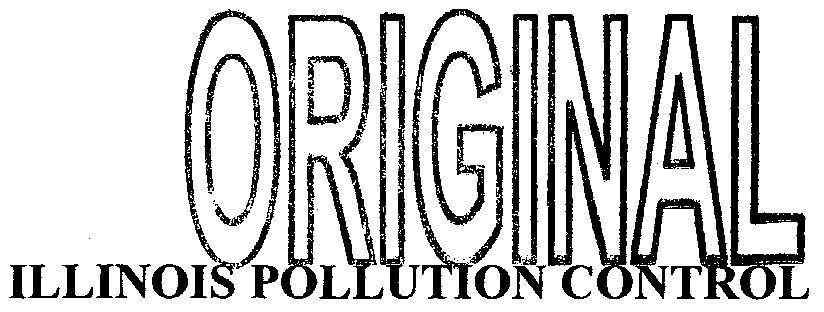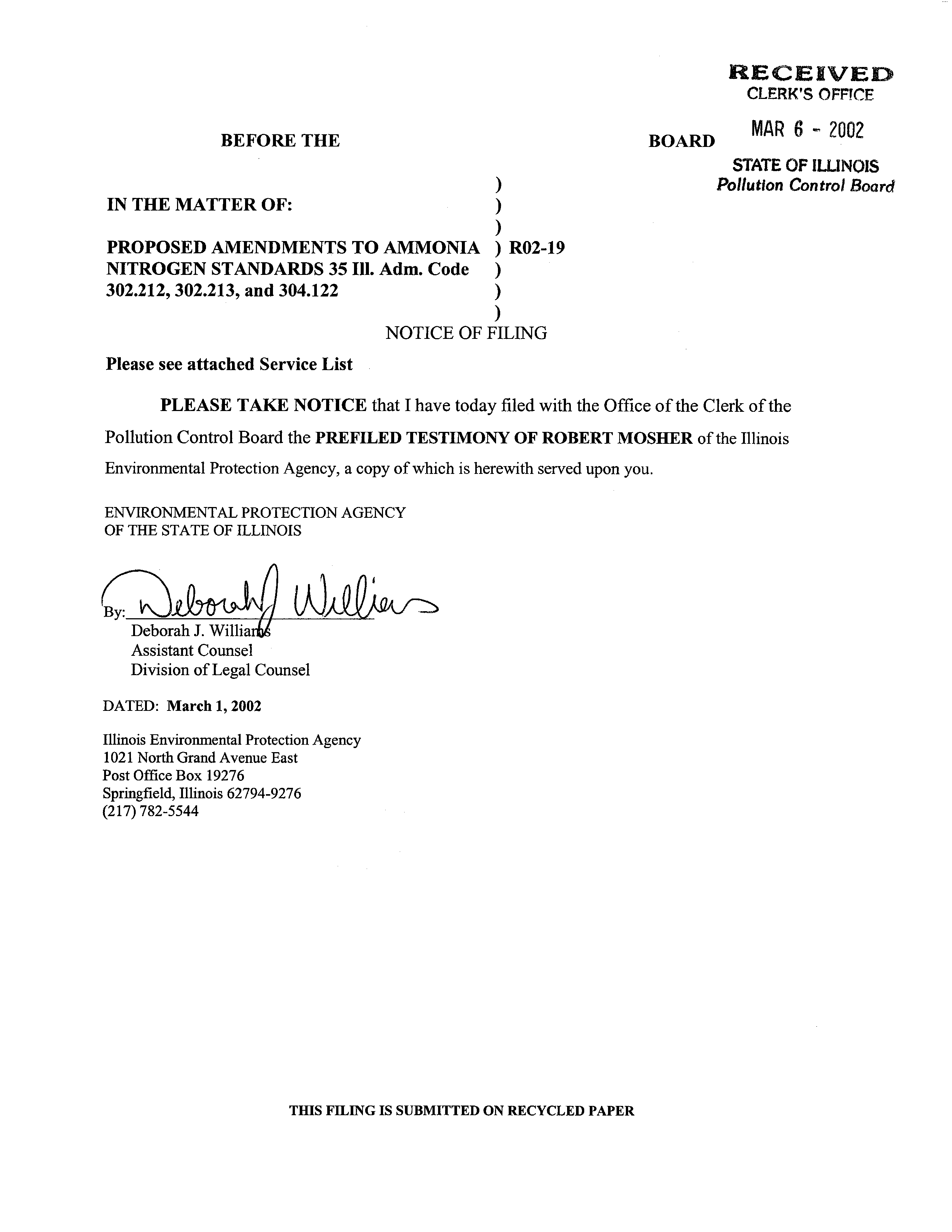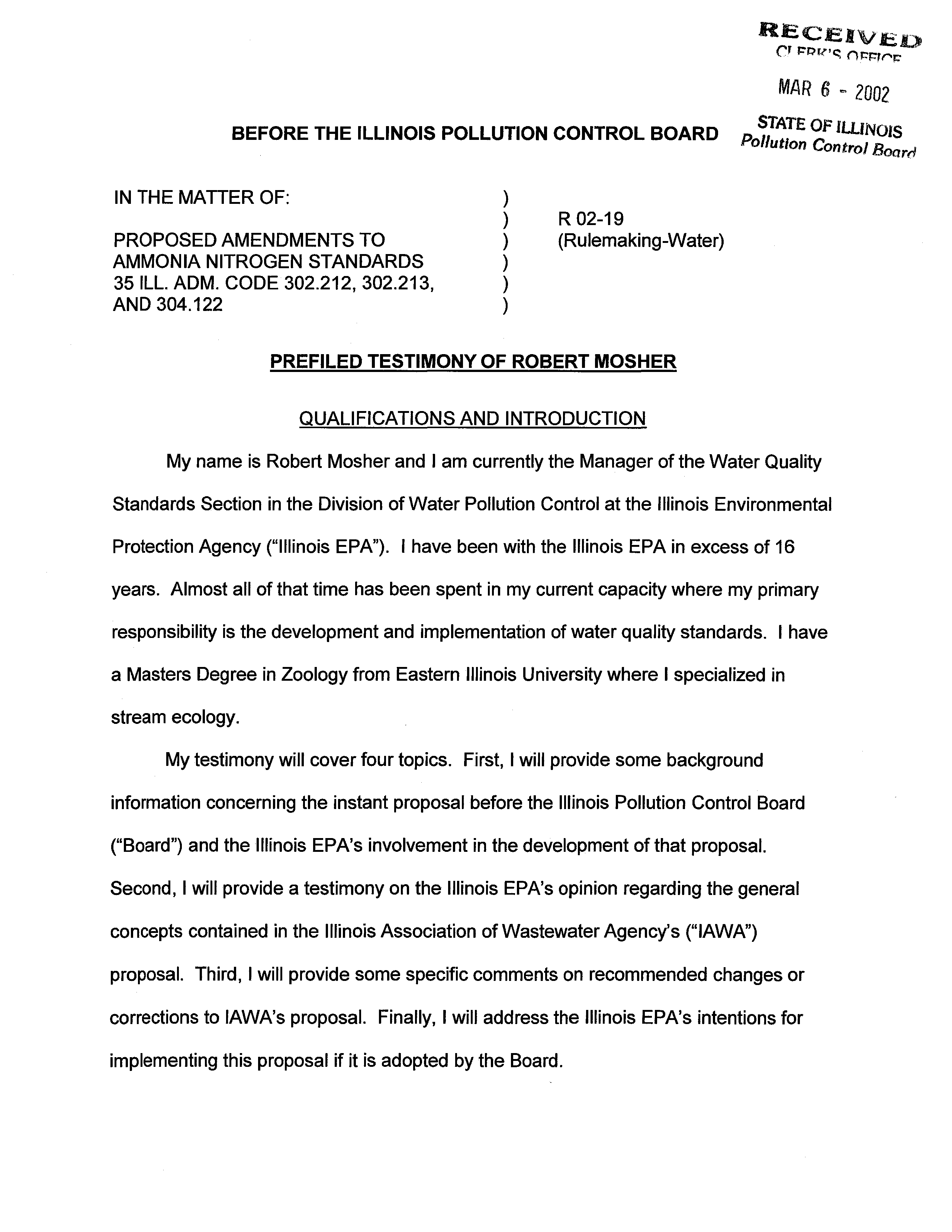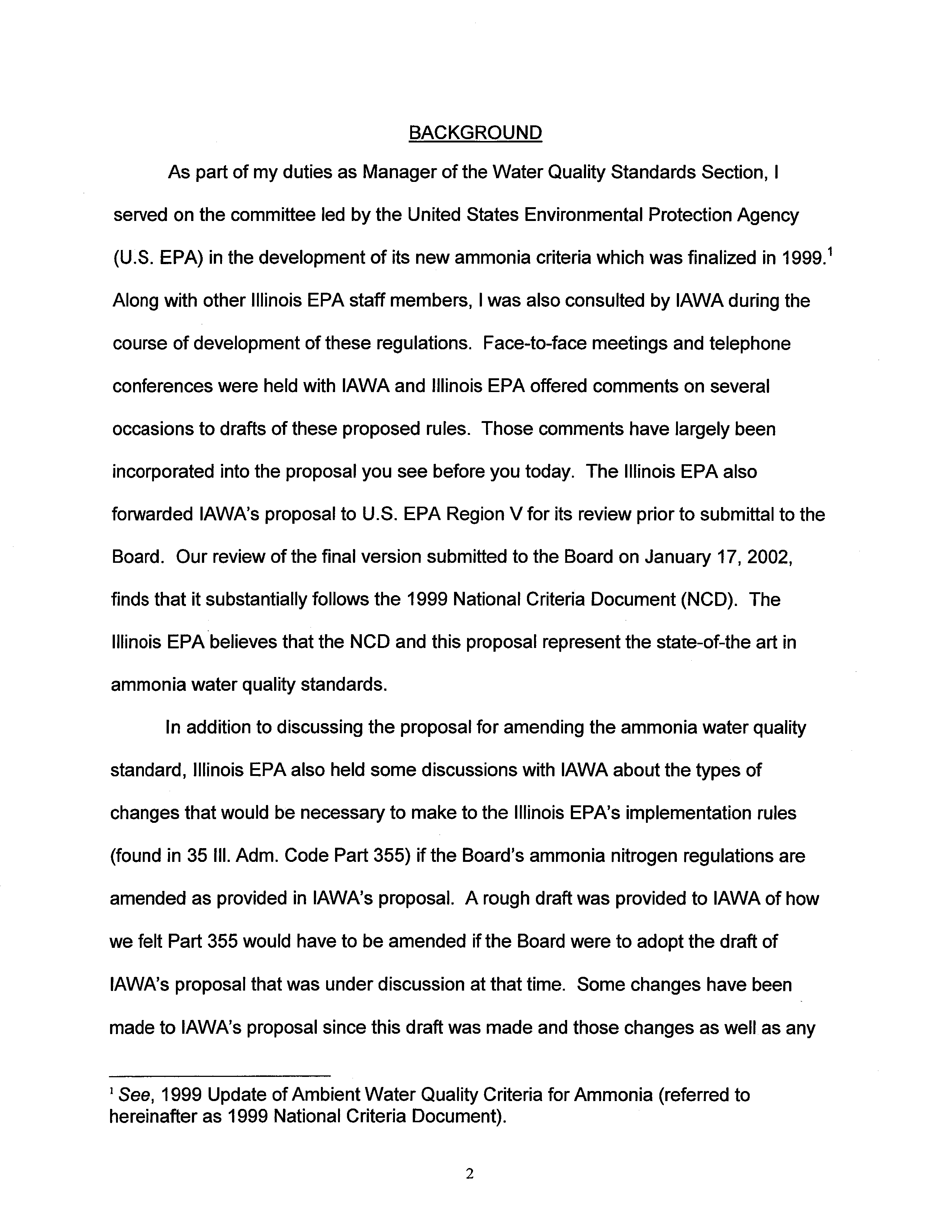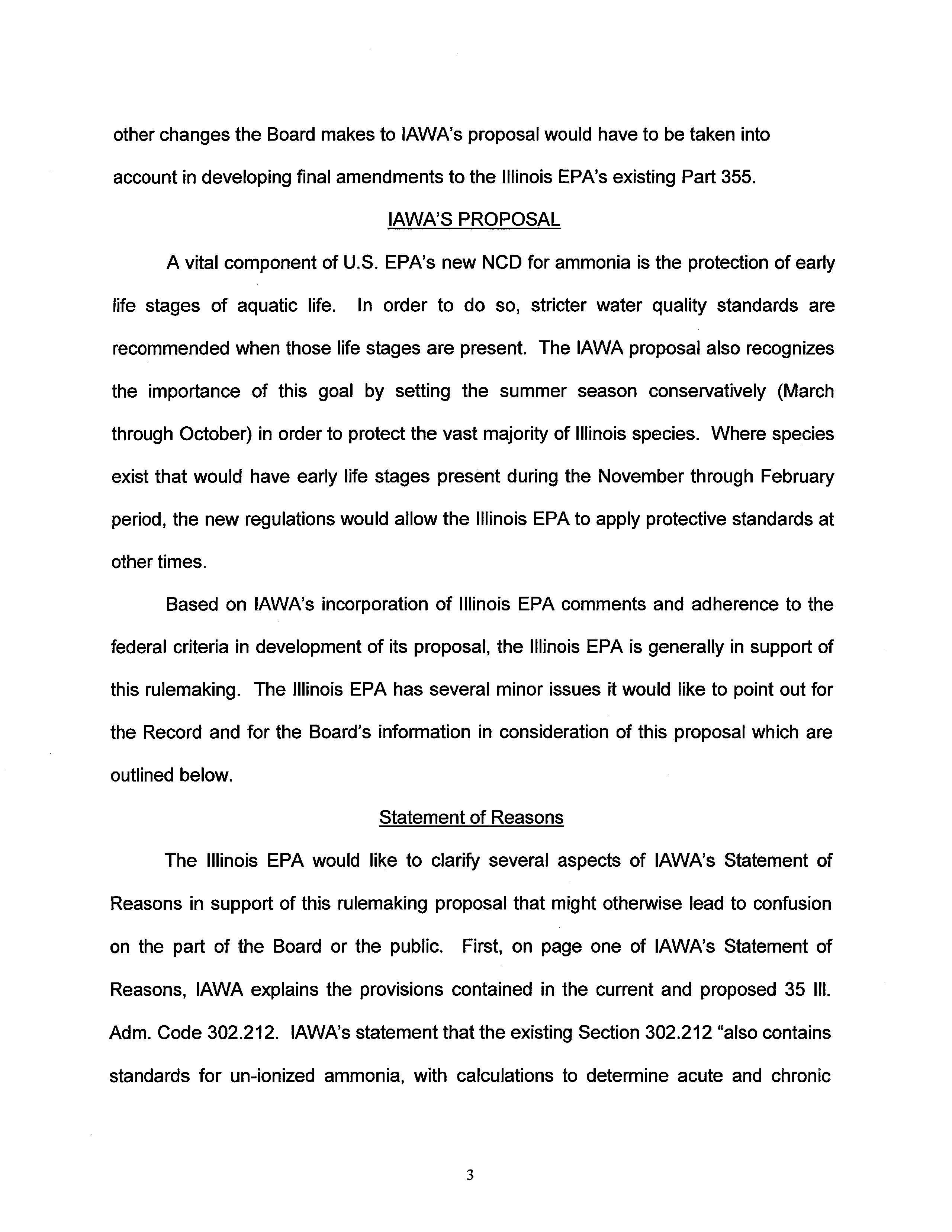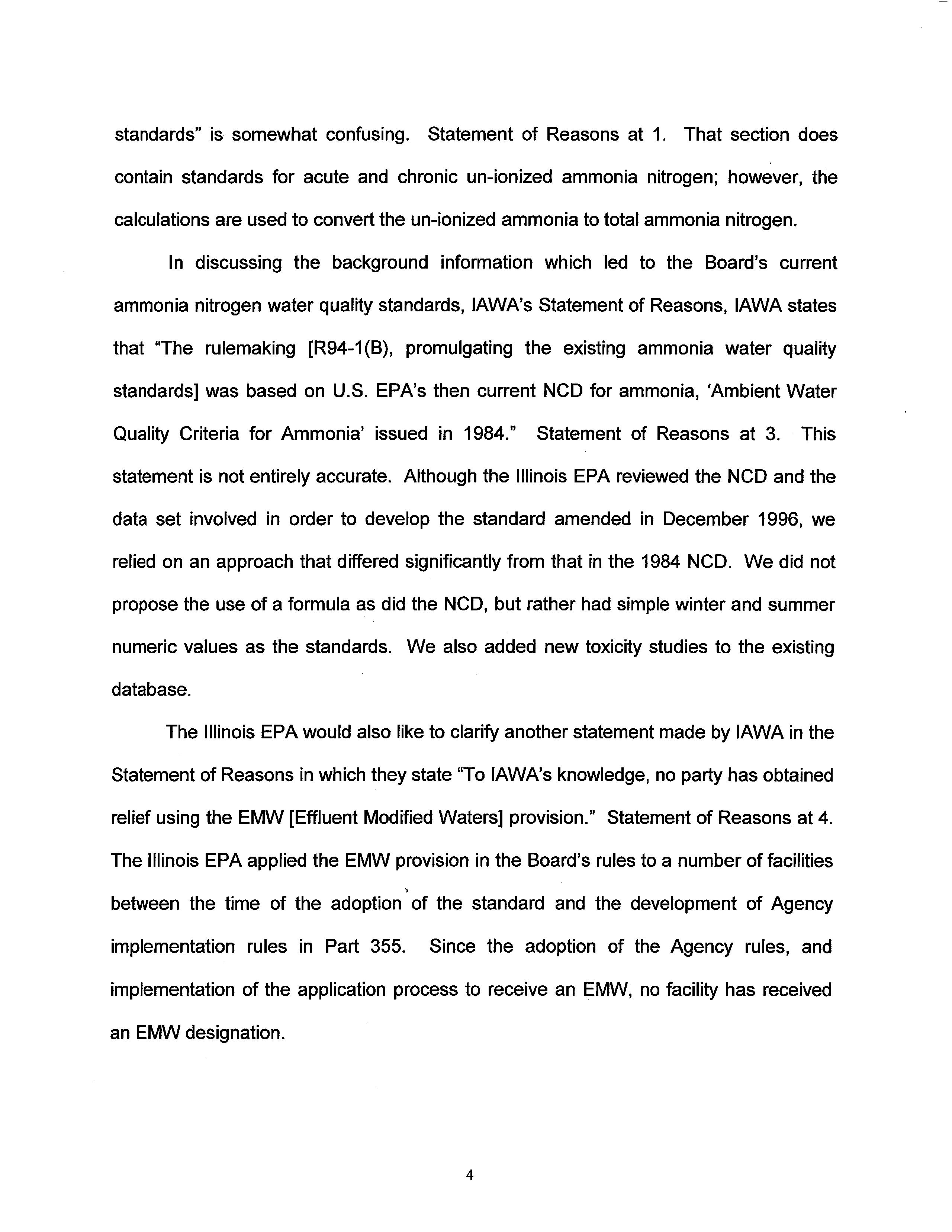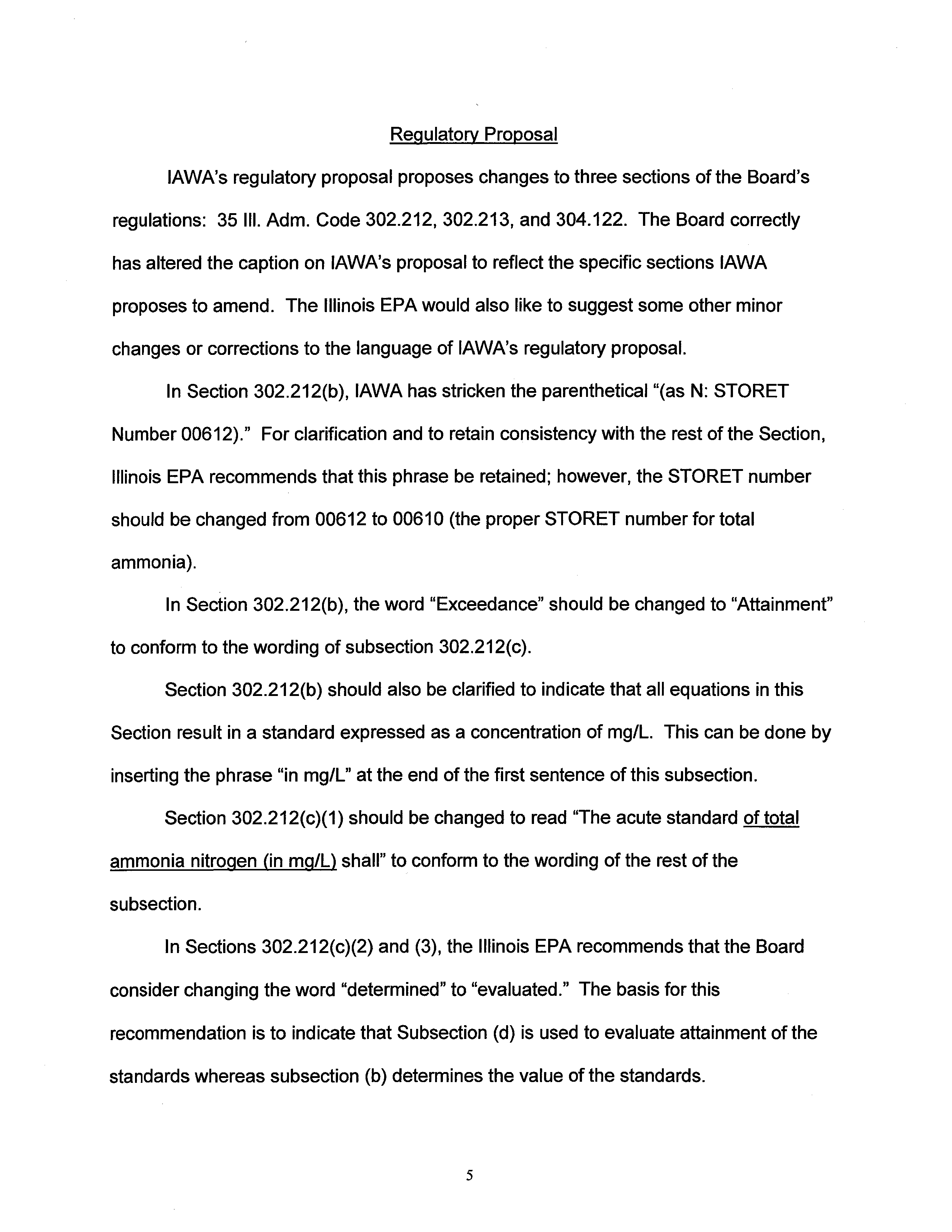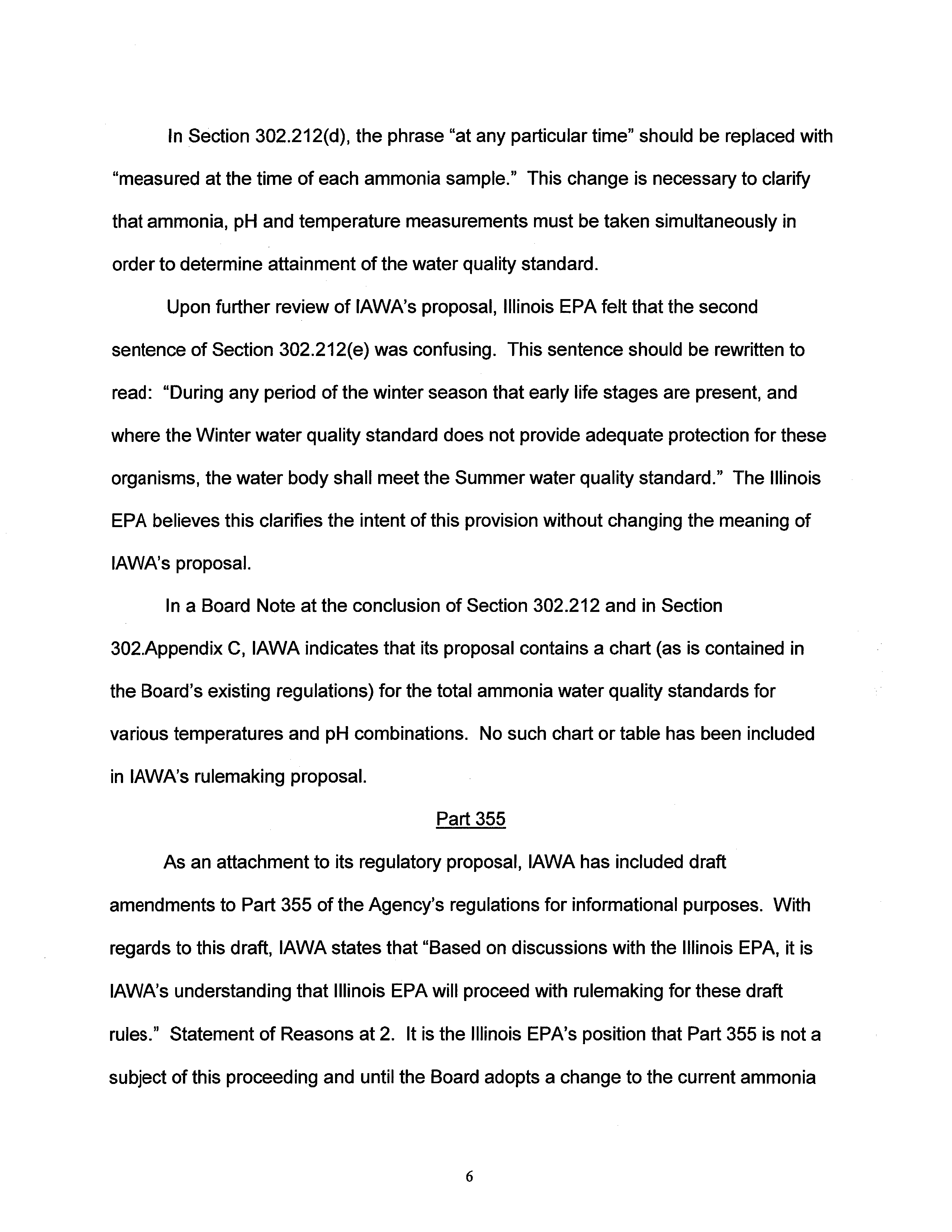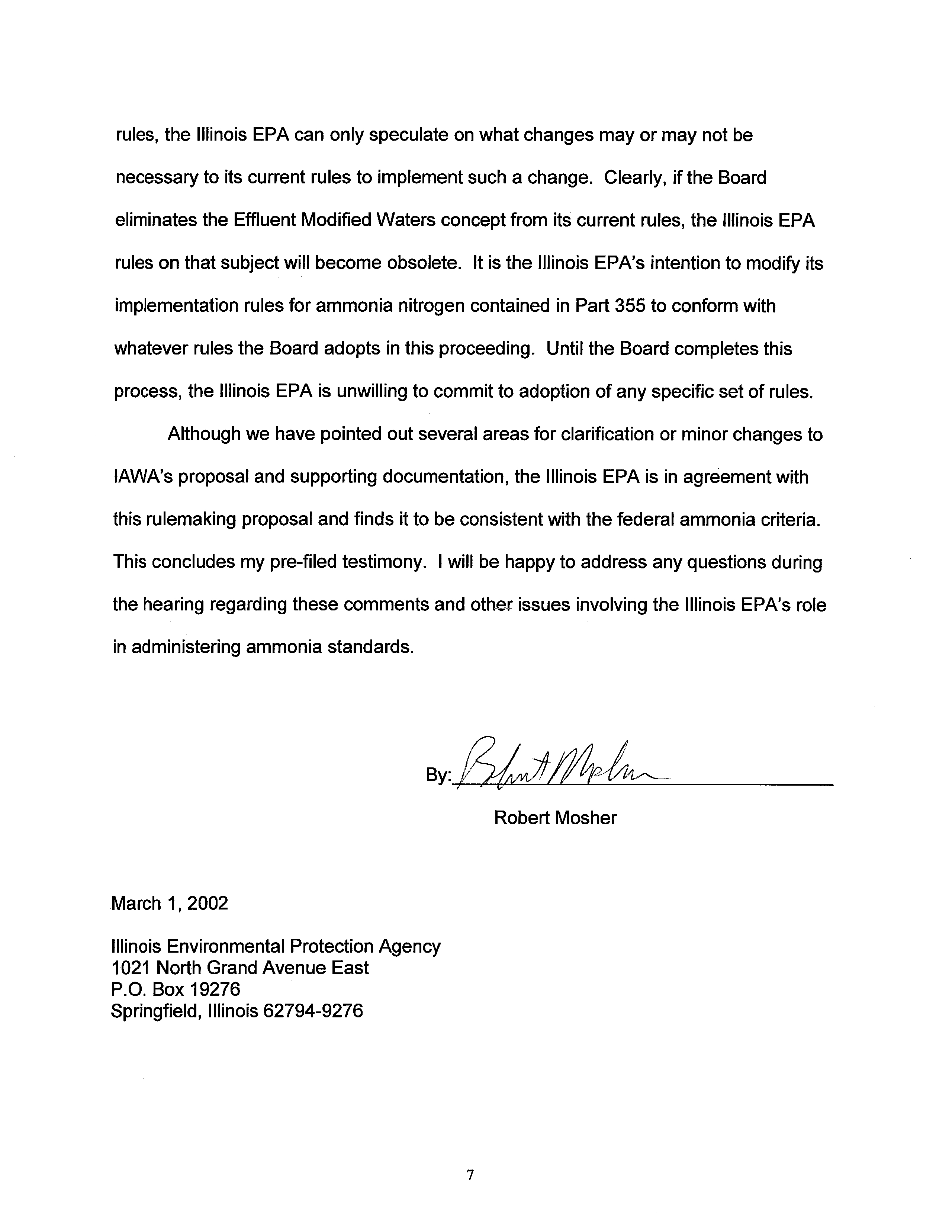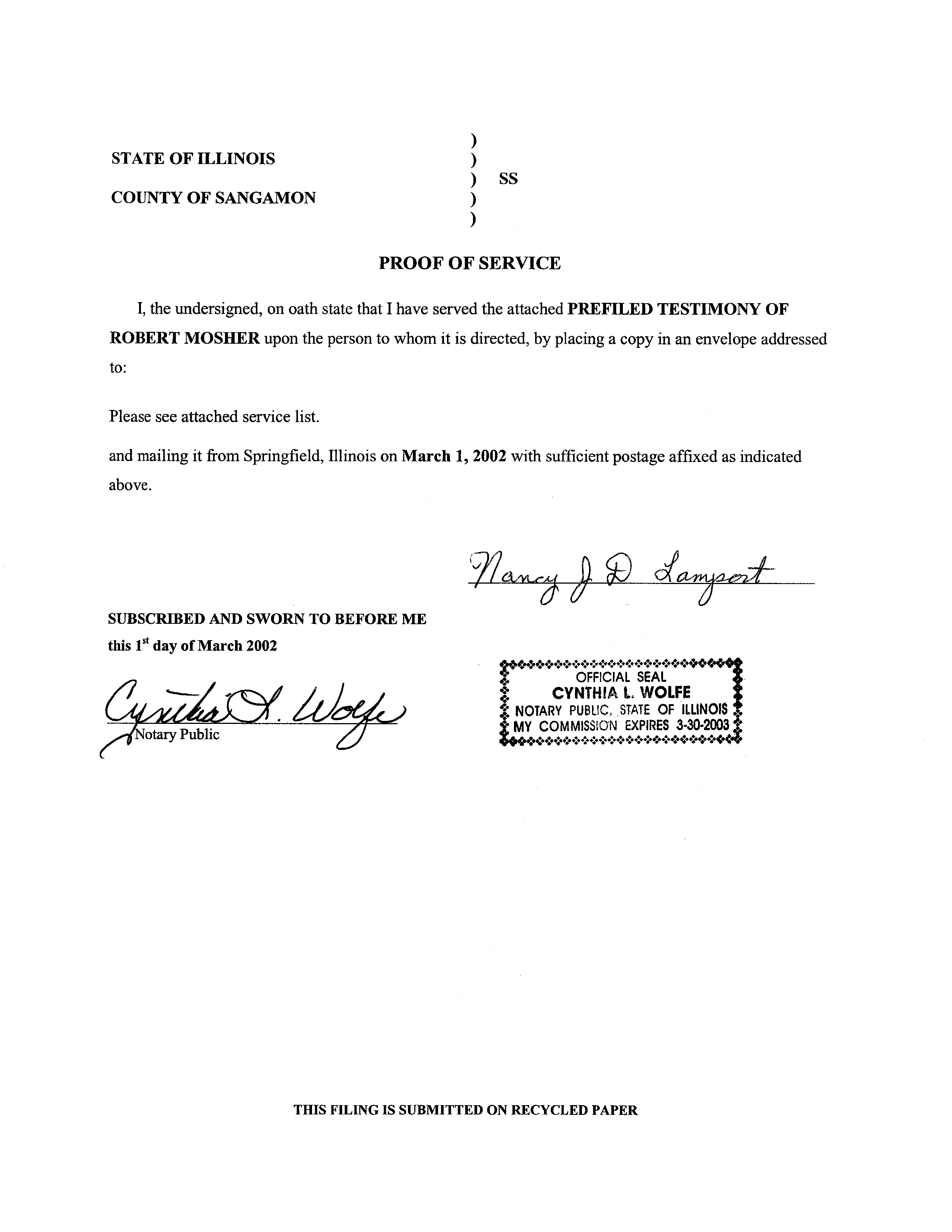RECEJVED
CLERK’S OFF!CE
BEFORE THE
BOARD
ML\R
6
2002
STATE OF
ILLINOIS
Pollution
Control Board
IN THE MATTER OF:
)
)
PROPOSED AMENDMENTS TO AMMONIA
)
R02-19
NITROGEN
STANDARDS
35111.
Adm. Code
)
302.212, 302.213, and 304.122
)
)
NOTICE OF FILING
Please see attached Service List
PLEASE TAKE
NOTICE
that I have today filed with the Office ofthe Clerk ofthe
Pollution Control Board the PREFILED TESTIMONY OF ROBERT MOSHER ofthe Illinois
Environmental Protection Agency, a copy of which is herewith
served
upon you.
ENVIRONMENTAL PROTECTION AGENCY
OFTHE STATE OF ILLINOIS
~LQY~~J~
tAQ)~~m
Deborah J. Willia
Assistant Counsel
Division of Legal Counsel
DATED:
March 1, 2002
Illinois Environmental Protection Agency
1021
North Grand Avenue
East
Post Office Box 19276
Springfield, Illinois 62794-9276
(217)
782-5544
)
TIllS
FILING
IS
SUBMITTED ON RECYCLED
PAPER
c’r
~r~v’ç ~
M/~R
6
2002
BEFORE THE
ILLINOIS POLLUTION
CONTROL BOARD
p
STATE
OF
ILLiNOIS
ollutjo,,
Control Roar,j
INTHEMATTEROF:
)
)
R02-19
PROPOSED AMENDMENTS TO
)
(Rulemaking-Water)
AMMONIA NITROGEN STANDARDS
)
35
ILL. ADM. CODE 302.212, 302.213,
)
AND 304.122
)
PREFILED TESTIMONY OF ROBERT MOSHER
QUALIFICATIONS AND INTRODUCTION
My name is
Robert Mosher and
I am currently the Manager of the Water Quality
Standards Section in the Division ofWater Pollution Control at the
Illinois Environmental
Protection Agency (“Illinois EPA”).
I
have been with the
Illinois EPA in excess of 16
years.
Almost all of that time has been spent in my current capacity where
my primary
responsibility is the development and implementation of water quality standards.
I have
a Masters Degree
in
Zoology from
Eastern Illinois
University where
I specialized
in
stream ecology.
My testimony will cover four topics.
First,
I will provide some background
information concerning the instant proposal before the Illinois Pollution Control Board
(“Board”) and the
Illinois EPA’s involvement in
the development of that proposal.
Second,
I will provide a testimony on the
Illinois EPA’s opinion
regarding the general
concepts
contained in the
Illinois Association of Wastewater Agency’s (“IAWA”)
proposal.
Third,
I will
provide some specific comments on recommended
changes or
corrections to IAWA’s proposal.
Finally,
I will address the
Illinois EPA’s intentions for
implementing this proposal if it is adopted by the Board.
BACKGROUND
As part of my duties as Manager of the Water Quality Standards Section,
I
served on the committee led by the
United States Environmental
Protection Agency
(U.S. EPA) in the development of its new ammonia criteria which was finalized
in
1999.1
Along with other Illinois
EPA staff members,
I was
also consulted by IAWA during the
course of development of these regulations.
Face-to-face meetings and telephone
conferences were
held with
IAWA and Illinois EPA offered
comments on several
occasions to drafts of these proposed rules.
Those comments have largely been
incorporated into the proposal you see before you today.
The Illinois
EPA also
forwarded IAWA’s proposal to U.S. EPA Region V for its
review prior to submittal to the
Board.
Our review of the final version submitted to the Board on January
17,
2002,
finds that it substantially follows the
1999 National Criteria Document (NCD).
The
Illinois EPA
believes that the NCD and this proposal represent the state-of-the art in
ammonia water quality standards.
In
addition to discussing the proposal for amending the ammonia water quality
standard,
Illinois EPA also held some discussions with
IAWA about the types of
changes that would be necessary to make to the
Illinois
EPA’s implementation rules
(found in
35
III. Adm. Code
Part 355) if the
Board’s ammonia nitrogen regulations are
amended as provided
in
IAWA’s proposal.
A rough draft was provided to IAWA of how
we felt Part 355 would have to be amended
if the Board were to adopt the draft of
IAWA’s
proposal that was under discussion at that time.
Some changes have been
made to IAWA’s proposal since this draft was made and those changes as well as any
See,
1999 Update ofAmbient Water Quality Criteria for Ammonia (referred to
hereinafter as 1999 National Criteria Document).
2
other changes the
Board makes
to IAWA’s proposal would have to be taken into
account in developing final amendments to the
Illinois
EPA’s existing Part 355.
IAWA’S PROPOSAL
A vital component of U.S.
EPA’s
new NCD for ammonia
is the protection of early
life
stages
of
aquatic
life.
In
order
to
do
so,
stricter
water
quality
standards
are
recommended when those life stages are present.
The IAWA proposal also recognizes
the
importance
of
this
goal
by
setting
the
summer
season
conservatively
(March
through October)
in
order to protect the vast majority of Illinois species.
Where species
exist that would
have
early
life stages present during
the November through
February
period, the new regulations would allow the
Illinois EPA to apply protective standards at
other times.
Based on
IAWA’s incorporation of
Illinois
EPA
comments and adherence to the
federal
criteria
in development of its proposal,
the
Illinois
EPA is generally
in support of
this rulemaking.
The Illinois
EPA
has several
minor issues it would
like to point out for
the
Record and for
the
Board’s information
in consideration of this
proposal which are
outlined below.
Statement of Reasons
The
Illinois
EPA
would
like
to
clarify
several
aspects
of
IAWA’s
Statement
of
Reasons
in support of this rulemaking
proposal that might otherwise
lead to confusion
on
the
part
of the
Board
or the
public.
First,
on
page
one
of
IAWA’s
Statement
of
Reasons,
IAWA explains the
provisions
contained
in
the
current and
proposed
35
III.
Adm. Code 302.212.
IAWA’s statement that the existing Section 302.212 “also contains
standards
for
un-ionized
ammonia,
with
calculations to
determine
acute
and
chronic
3
standards”
is
somewhat
confusing.
Statement
of
Reasons
at
1.
That
section
does
contain
standards
for
acute
and
chronic
un-ionized
ammonia
nitrogen;
however,
the
calculations are used to convert the un-ionized ammonia to total ammonia nitrogen.
In
discussing
the
background
information
which
led
to
the
Board’s
current
ammonia nitrogen water quality standards,
IAWA’s Statement of Reasons,
IAWA states
that
“The
rulemaking
R94-1(B),
promulgating
the
existing
ammonia
water
quality
standards
was
based
on
U.S.
EPA’s
then current
NCD for
ammonia,
‘Ambient Water
Quality
Criteria
for
Ammonia’
issued
in
1984.”
Statement
of
Reasons
at
3.
This
statement
is not entirely accurate.
Although the
Illinois
EPA reviewed the
NCD and the
data
set
involved
in
order
to
develop
the
standard
amended
in
December
1996,
we
relied on
an approach that differed significantly from that in
the
1984 NCD.
We did not
propose the
use of a formula as did the
NCD, but rather had simple winter and summer
numeric values as
the standards.
We
also
added
new toxicity studies to the
existing
database.
The Illinois
EPA would also like to clarify another statement made by IAWA in
the
Statement of Reasons
in which they state “To IAWA’s knowledge,
no party has obtained
relief using
the
EMW Effluent
Modified Waters
provision.”
Statement of Reasons at 4.
The Illinois
EPA applied the
EMW provision
in
the Board’s rules to a number of facilities
between
the
time
of the
adoption
of
the
standard
and
the
development
of Agency
implementation
rules
in
Part
355.
Since
the
adoption
of
the
Agency
rules,
and
implementation of the
application
process to
receive an
EMW,
no facility has
received
an
EMW designation.
4
Regulatory Proposal
IAWA’s regulatory proposal proposes changes to three sections ofthe
Board’s
regulations:
35
III. Adm.
Code 302.212, 302.213, and 304.122.
The Board correctly
has altered the caption on IAWA’s proposal to reflect the specific sections IAWA
proposes to amend.
The Illinois
EPA would also like to suggest some other minor
changes or corrections to the language of IAWA’s regulatory proposal.
In Section 302.212(b),
IAWA has stricken the parenthetical “(as N:
STORET
Number
00612).”
For clarification
and to retain consistency with the
rest ofthe Section,
Illinois EPA recommends that this phrase be retained; however, the STORET number
should
be changed from 00612 to 00610 (the proper STORET number for total
ammonia).
In Section 302.212(b), the word “Exceedance” should
be changed to “Attainment”
to conform to the wording of subsection
302.212(c).
Section 302.21 2(b) should also be clarified to indicate that all equations
in this
Section result in a standard expressed as a concentration of mg/L.
This can be done by
inserting the phrase “in mg/L” at the end of the first sentence of this subsection.
Section 302.212(c)(1) should
be changed to read “The acute standard of total
ammonia nitrogen (in mg/L) shall” to conform to the wording of the
rest ofthe
subsection.
In Sections 302.212(c)(2) and (3), the
Illinois
EPA recommends that the
Board
consider changing the word “determined” to “evaluated.”
The basis for this
recommendation is to indicate that Subsection (d)
is used to evaluate attainment ofthe
standards whereas subsection
(b) determines the value of the standards.
5
In Section 302.212(d), the phrase “at any particular time” should
be replaced with
“measured at the time of each ammonia sample.”
This change is necessary to clarify
that ammonia,
pH and temperature measurements must be taken simultaneously in
order to determine attainment of the water quality standard.
Upon further review of IAWA’s proposal, Illinois EPA felt that the second
sentence of Section 302.212(e) was confusing.
This sentence should
be rewritten to
read:
“During any period of the winter season that early life stages are present, and
where the Winter water quality standard does
not provide adequate protection
for these
organisms, the water body
shalt meet the Summer water quality standard.”
The Illinois
EPA believes this clarifies the intent of this provision without changing the meaning of
IAWA’s proposal.
In a
Board Note at the conclusion of Section 302.212 and in
Section
302.Appendix C,
IAWA indicates that its proposal contains a chart (as is contained
in
the Board’s existing regulations) for the total ammonia water quality standards for
various temperatures and pH combinations.
No such chart or table has been included
in
IAWA’s rulemaking proposal.
Part 355
As an attachment to its
regulatory proposal,
IAWA has included draft
amendments to Part 355 of the Agency’s regulations for informational purposes.
With
regards to this draft, IAWA states that “Based
on discussions with
the
Illinois EPA,
it is
IAWA’s understanding that Illinois
EPA will proceed with rulemaking for these draft
rules.”
Statement of Reasons at 2.
It is the Illinois
EPA’s position that Part 355 is not
a
subject of this proceeding and until the Board adopts a change to the current ammonia
6
rules, the
Illinois
EPA can only speculate on what changes may or may not be
necessary to
its current rules to implement such a change.
Clearly,
ifthe
Board
eliminates the Effluent Modified Waters concept from
its current rules, the
Illinois EPA
rules on that subject will
become obsolete.
It is the Illinois
EPA’s intention to modify its
implementation rules for ammonia nitrogen contained
in Part 355 to conform with
whatever rules the Board adopts
in this proceeding.
Until the Board completes this
process, the
Illinois EPA is unwilling to commit to adoption of any specific set of rules.
Although we have pointed out several areas for clarification or minor changes to
IAWA’s proposal and supporting documentation, the
Illinois EPA is
in
agreement with
this rulemaking proposal and finds it to be consistent with the federal ammonia criteria.
This concludes my pre-filed testimony.
I will be happy to address any questions during
the hearing regarding these comments and other issues involving the
Illinois EPA’s role
in administering ammonia standards.
By:___________
Robert Mosher
March
1, 2002
Illinois Environmental
Protection Agency
1021
North Grand Avenue East
P.O.
Box 19276
Springfield,
Illinois 62794-9276
7
)
STATE
OF ILLINOIS
COUNTY OF SANGAMON
)
)
)
)
SS
PROOF OF SERVICE
I, the undersigned, on oath state that I have served the attached PREFILED TESTiMONY
OF
ROBERT
MOSHER upon the person to whom it is directed, by placing a copy in an envelope addressed
to:
Please see attached service list.
andmailing it from Springfield, Illinois
on
March 1,
2002 with sufficient postage affixed as indicated
above.
I /
II
A/I
A1
SUBSCRIBED AND
SWORN
TO
BEFORE ME
this l’~
day of March 2002
(~ary
Public
OFF!C~ALSEAL
-
CYNTHIA
L
WOLFE
$
NOTARY
PUBUC~ STATE
OF
ILLINOIS
f
MY
COMMISSK)N
EXPIRES
3-30-2003
+
THIS
FILING
IS
SUBMITTED ON RECYCLED PAPER
SERVICE LIST
R02-19
March
1, 2002
Dorothy Gunn, Clerk
Illinois Pollution Control Board
100 West Randolph, Suite 11-500
Chicago, Illinois
60601
CatherineGlenn
Illinois Pollution Control Board
100 West Randolph,
Suite 11-500
Chicago, Illinois
60601
Mike Callahan
Bloomington Normal
Water Reclamation District
Post Office Box 3307
Bloomington, Illinois
61702-3307
Larry Cox
Downer’s Grove Sanitary District
2710
Curtiss Street
Downer’s Grove, Illinois
60515
Dennis Daffield
Departmentof Public Works City ofJoliet
921 East Washington Street
Joliet, Illinois
60433
Sheila Deely
Gamder, Carton and Douglas
321 North Clark Street, Suite 3400
Chicago,
illinois
60610-4795
Albert Ettinger
Environmental Law and Policy Center
35 East Wacker Drive, Suite 1300
Chicago, Illinois
60601-2110
Susan M. Franzetti
Sonnenschein Nath and Rosenthal
8000 Sears Tower
233
SouthWacker Drive
Chicago, illinois
60606
Lisa Frede
Chemical Industry Council
9801
West Higgins Road, Suite
515
Rosemont, illinois
60018
James T. Harrington
Ross and Hardies
150 North Michigan, Suite 2500
Chicago, illinois
60601
Katherine Hodge
Hodge, Dwyer Zeman
3150 Roland Avenue
Post Office Box 5776
Springfield, Illinois
62705-5776
Margaret Howard
Hedingerand Howard
1225 South Sixth Street
Springfield, Illinois
62703
Robert Messina
illinois Environmental Regulatory Group
215 EastAdams Street
Springfield, Illinois
62701
TomMulh
Fox MetroWalter Reclamation District
682 State Route 31
Oswego, Illinois
60543
Irwin Polls
Metropolitan WaterReclamation
District of Chicago
Environmental Monitoring Division
6001 West Pershing Road
Cicero, illinois
60804-4112
David Zenz
CTE Engineers
303 East Wacker Drive, Suite 600
Chicago, Illinois
60601
THIS
FILING
IS SUBMITTED ON
RECYCLED PAPER
